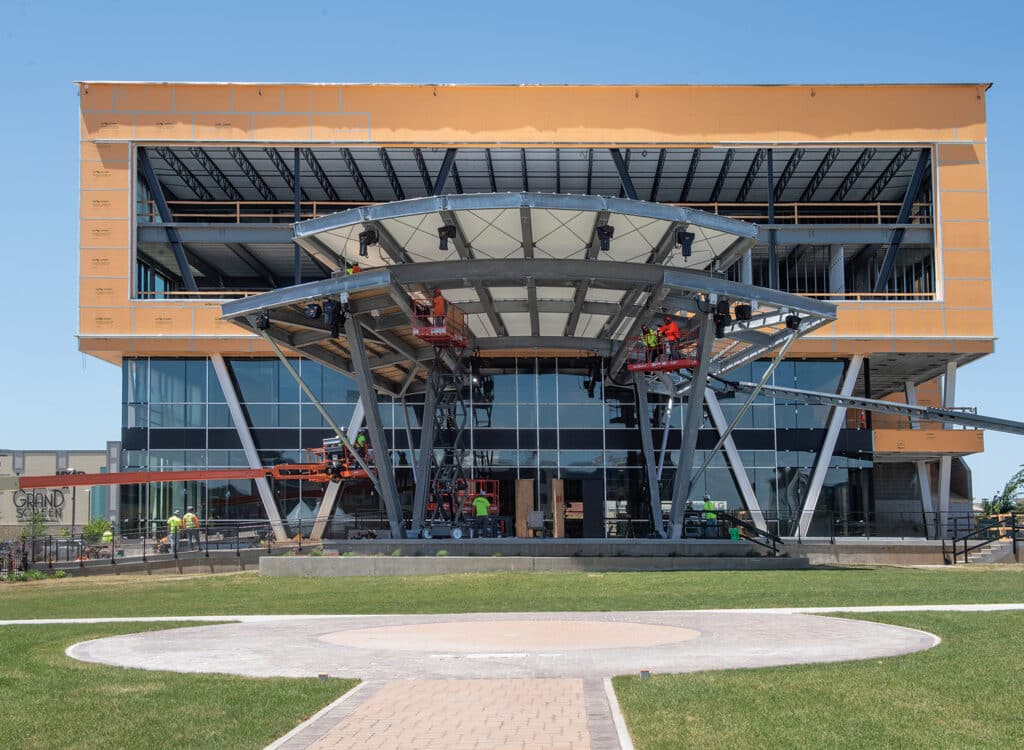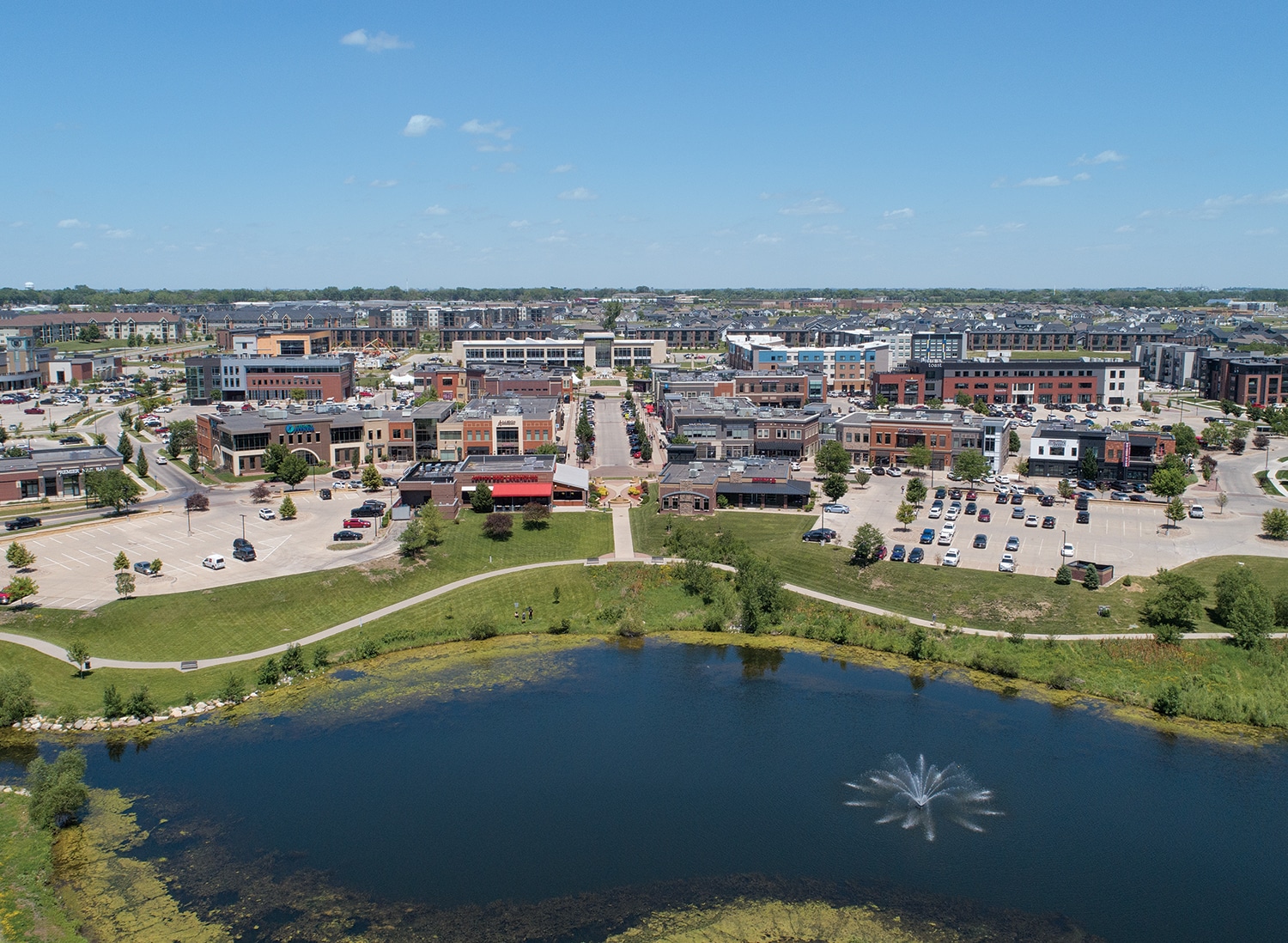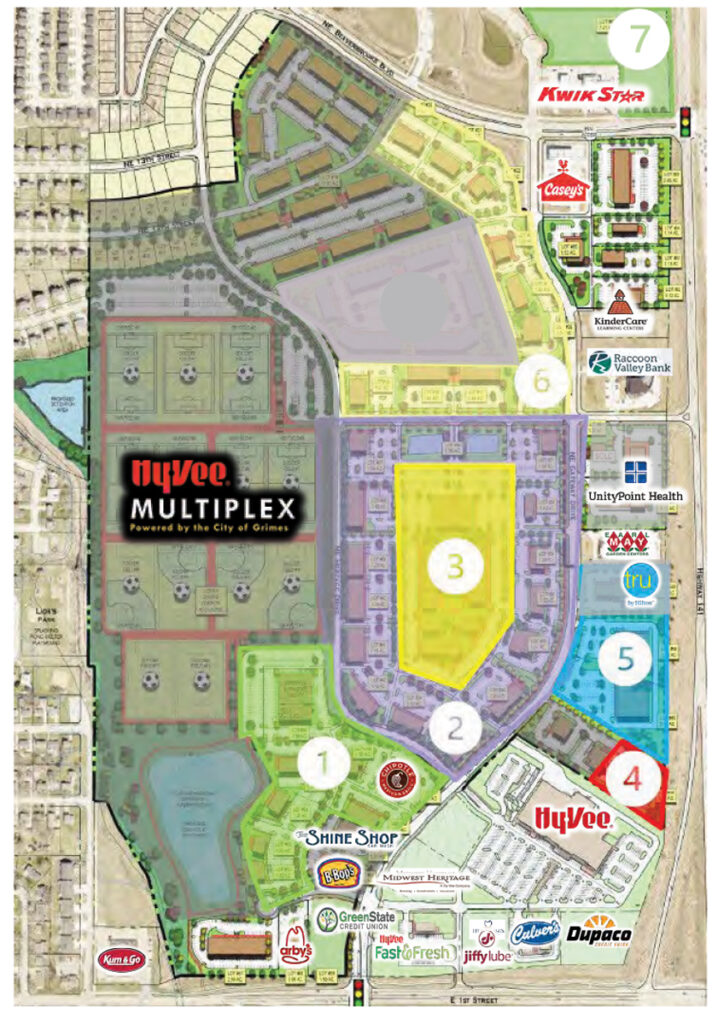Concept to Community
The District at Prairie Trail overcomes early struggles to become major economic driver

What started as an idea by Ankeny developer Dennis Albaugh has grown into a major economic driver for the city, drawing nearly 600,000 visitors a year with its shops, restaurants and outdoor events.
The District at Prairie Trail — and its adjacent neighborhood — began in 2007. It weathered the economic downturn of the late 2000s, the crash of the housing market and the Great Recession, and today 75 businesses call the District home.
More than 4,200 people live in Prairie Trail, and that combination of residential and commercial development has created a vibrant, New Urbanism neighborhood that makes it an attractive place for people to live, work and play, said Ashley Johnson, chief operating officer for DRA Properties LC, the Ankeny-based developer behind the District at Prairie Trail.
If the District were its own standalone city, it would be bigger than 94% of all other Iowa communities. It had 2.9 million unique visits in 2023, with visitors spending an average of nearly four hours per visit, according to the retail tool Placer.ai, used by brokerage firm JLL, which markets the district.
The District, which sits on about 60 acres, is the commercial hub designed around a town square concept. Everything surrounding that, from Northwest Irvinedale Drive to North Ankeny Boulevard, is what is referred to as Prairie Trail. In all, there are 1,100 acres split by Southwest State Street.
That includes 13 miles of walking trails, 200 acres of parks, and elementary, middle and high schools. There also is senior living, independent and assisted living and dementia care facilities. And don’t forget three hotels.
“So the purpose of this is that this is really a town within a town,” Johnson said.

Derek Lord, Ankeny’s economic development director, said the District has proved to be a destination for those who visit.
“It shows that critical mass of options where it becomes an evening out,” he said. “It’s not a destination to eat and leave. It’s a destination to shop or go out for dinner, maybe go to a movie, or do something else. So the amount of time people spend is also pretty significant.”
Today, only a few commercial lots remain available to be developed in the District, and fewer than 30 of the 1,200 residential lots are available for construction.

“I remember this used to be the [Iowa State University Dairy Research Farm] years and years ago and it was actually on my original bus route to elementary school,” said Marcus Pitts, senior managing director at JLL and an Ankeny native. “I remember bouncing around the back of a bus on those dusty roads growing up, so seeing it convert to what it is today is pretty rewarding.”
The beginning
The city of Ankeny was quickly growing around the site that housed the ISU farm, and Johnson said city officials were looking for ways to provide connectivity to the fast-growing community that today has more than 72,000 residents. But a state law at the time prohibited the university from selling the property without the proceeds going into the state’s general fund, she said.
“So what happened in the early 2000s was several stakeholders in the community got together and worked with the state and got that legislation changed,” Johnson said. “Once that happened, the university was allowed to sell the farm and use the proceeds to go build a new farm, which they did.”
Johnson said the city took a look at the property and gave DRA a clear vision.
“As a developer you see all that green [on the map] and really think about how you’re going to make money, right, because that’s a lot of not-revenue-producing area,” she said. “So we kind of had to learn a lot about New Urbanism.”
A development agreement was reached with the city of Ankeny and a master plan was drawn.
Part of that process included looking at what already existed in the region and how this new development would be different, Johnson said.
“So that’s how we started the District,” she said. “To be successful, you’re going to need a regional draw. We went from that approach and said, ‘What does not only the Ankney community need, but what does the larger region need so we attract people from West Des Moines, Waukee, Ames?’ So that’s what we tried to design way back when, and now we’re seeing it come to fruition.”
The first street in Prairie Trail went in in 2007 with a goal of building homes for the 2008 Home Show, Johnson said.
“I can’t remember the number of houses in the first Home Show, very nice homes sitting there, and the market kind of fell apart right after that,” she said. “It was a couple of tough years early on, and we were just trying to figure it out.”
So they took the leap, resulting in the construction of the building where Jethro’s is now located.
“I remember the day when we said we’re going to build the first building and see what happens,” she said.
Today, the District is creating a demand for office space because of the amenities available that are accessible to people who work there, Johnson said.
“There are so many amenities right here that employers are finding out that they can rent less square footage and still provide employees the amenities that attract and retain employees without having to put them inside their space and pay for them,” she said.

Overcoming economic downturn
Pitts, who was with Ruhl & Ruhl Commecial Co. at the time, said there was initial excitement about marketing the District. Hy-Vee had committed to build, and there was some residential construction beginning.
“We started with a lot of calls to groups that we had hoped would have interest and a lot of selling the vision,” he said.
There were maps of where roads would go and digital renderings of what Pitts described as “pretty pictures of buildings.” Albaugh’s vision was to put up buildings speculatively. Pitts has represented DRA in Prairie Trail since the development began.
Once anchors such as B&B Theaters, the library and the Residence Inn went up, it helped those marketing efforts, he said.
“I know there were a lot of challenging times on the front end, but as long we kept making the calls and reporting back, we had a lot of in-person meetings [with DRA], and the amount of meetings we had with groups on the front end, I can’t even count,” Pitts said. “We kept reaching out and driving all over looking at little pockets and we’d come back with 15 to 20 names and start calling them and inviting them to Ankeny to tour the development, meet with the Albaugh family and just learn more trying to get people interested.”
There were also a lot of “no’s” along the way, Pitts said.
“There were uncertain times for sure,” he said.
Johnson said that, despite the early economic challenges, DRA persevered and didn’t waver from its initial vision for Prairie Trail and the District.
“We held on and kept the vision forefront and really worked to figure out how to execute that so we could end up with the project that we have today,” she said.
Choosing the District
Picking the District was a no-brainer for Tom Baldwin when he looked for a place to open his restaurants.
Baldwin, who owns Grimaldi’s Pizzeria and the Breakfast Club, said the design of the District, its walkability and the vibrant environment it creates with its community events made it an ideal location.
“It’s just a great business development,” said Baldwin, who also plans to open a third business in the District later this fall. “It has a good mix of office, retail, food and beverage. It has a lot of curb appeal. They draw a lot of traffic with the hotel business and the festivals they throw in the summer. It’s just an all-around great environment and I don’t see that anywhere else in Iowa, so for me, that’s ground zero for Ankeny entertainment.”
He said the data shows visitors to the District stay a while, and that is good for businesses that locate there.
“There’s a good mix of uses there,” he said. “That means they’re not coming to just one place. They’re making multiple stops. There’s plenty of parking. And you can park once. You cannot underestimate the walkability there. It invites people to get out and walk around.”
Kasey Jones, the district manager overseeing the Breakfast Club’s three metro locations, said the District also fosters a sense of community.
“Being born and raised in Ankeny, we’ve seen it grow over time and very fast,” she said. “It used to be a small town where you saw everyone you know at Target or wherever, you always knew someone, but now with the District where they have events where they bring people together, it brings back that small-town vibe that Ankeny used to have. Even though [Ankeny] is growing so much, it’s still bringing everyone together.”
Importance to Ankeny
Lord said the combination of residential, commercial, green space and walkability that Prairie Trail offers provided choices that didn’t previously exist in Central Iowa.
“It’s one of those areas that you can just make a decision to go there and decide what you want to do when you get there,” he said. “Historically, that concentration of amenities hadn’t existed in Ankeny.”
The impact of Prairie Trail extends beyond just that immediate area, Lord said.
“It’s a driver for the entire community,” he said. “There are people that choose to live in Ankeny because of the amenities and options available in Prairie Trail. There are people who live near Prairie Trail because they’re in close proximity or along a bike trail to get to the District. So the benefits and population impacts extend well beyond the boundaries of the District itself.”
The city has issued about $1 billion in permits for Prairie Trail and the District since it was created, Lord said.
“The overall economic value to the community far exceeds a billion dollars of assessed valuation, which allows us to provide the high-quality level of services and amenities that people expect in Ankeny,” he said.
And it’s those services and amenities that make Ankeny attractive to businesses and their employees, Lord said.
“Businesses are chasing people, and if you’re creating spaces where people want to live, you’re going to continue to drive residential growth, and that’s going to continue to be attractive to those businesses looking to relocate and grow their workforce,” he said.

Danielle Siefert, of Danielle Seifert Real Estate Professionals Group, lives in Prairie Trail and has her office in the District. She said whether someone lives in Prairie Trail or lives elsewhere in the region, they know Prairie Trail and the District is a destination for their family.
And the proximity and ease of commute complements other entertainment and recreation opportunities in the metro, she said.
Siefert said builders were creative in building a space for multiple generations of people to live in Prairie Trail as they adapted to the downturn of the late 2000s.
“They weren’t all luxury homes, all the big ones the Home Show had, and people brought different price points to Prairie Trail without giving up the whole vision,” she said.
She said a young family can move up, or an older couple can downsize to a smaller home, townhome or condo.
“It ended up working out perfectly — you don’t have to leave Prairie Trail,” Siefert said.
Pitts said Prairie Trail and the District have created a commercial ecosystem that has benefited the entire community.
“It’s tough to find retail space in Ankeny, and they’ve created this big box store area, you have your New Urbanism with the District, you have your older areas like Uptown, and there’s a different seat for every business, so it’s been really good,” he said.
Lord said that synergy between Prairie Trail and Uptown makes the area a regional draw.
“It brings people in from outside our community and outside our region,” he said. “We’re seeing it with different conferences and state associations, and what that does is gives us an opportunity to showcase our community. So it opens some doors for us, whether it’s new business development or new residents considering moving to the Des Moines metro.”

Michael Crumb
Michael Crumb is a senior staff writer at Business Record. He covers real estate and development and transportation.











